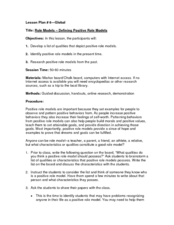Curated OER
Draw a Computer
In this computer lesson plan, students examine the various parts of the computer using terms - computer, keyboard, monitor, mouse, on/off switch, headphones, speaker. They repeat vocabulary and discuss correct operation and safety.
Name Parts of a Computer and Terms for Interface Elements
Familiarize your young learners with the parts of a computer and some basic key terms relating to technology. As the teacher demonstrates using an LCD projector, class members practice moving a mouse, opening the Internet, typing in a...
Bonneville
Unique Solar Cell Model Sketch and Presentation
There's always room for improvement. Continuing from the previous lesson, learners first create a two- or three-dimensional model of their solar cell designs. They then give short presentations to the rest of the class and receive...
Curated OER
Role Models - Defining Positive Role Models
Being able to identify what characteristics make a good role model is one way for learners to better understand their own positive behaviors. The class brainstorms what characteristics make up a good role model, research a role model...
EngageNY
Modeling Riverbeds with Polynomials (part 2)
Examine the power of technology while modeling with polynomial functions. Using the website wolfram alpha, learners develop a polynomial function to model the shape of a riverbed. Ultimately, they determine the flow rate through the river.
EngageNY
Modeling Riverbeds with Polynomials (part 1)
Many things in life take the shape of a polynomial curve. Learners design a polynomial function to model a riverbed. Using different strategies, they find the flow rate through the river.
EngageNY
Modeling Linear Relationships
Math modeling is made easy with the first installment of a 16-part module that teaches pupils to model real-world situations as linear relationships. They create graphs, tables of values, and equations given verbal descriptions.
Brigham Young University
Computer Age
Theater arts class members get a chance to see how professionals employ tech tools. As they sketch, render, build models, and prepare presentations of the set design for a current show, learners either visit a professional theater or by...
Curated OER
Slush Rush
Young scholars navigate software to help students understand the benefits of computer models. In this computer models lesson, young scholars use computer inquiry tools to record simulated events and how they affect objects such as...
Ontario
Animation Programming—Computer Studies
Introduce high schoolers interested in animation programming to fundamental programming concepts so that they can plan and write simple programs.
Curated OER
A Computer Model For a Recycling Center
Students develop a working model computer program of a recycling center addressing the material management, work schedules and business finances of running the recycling center.
Mathalicious
XBOX Xpotential
Touchdown! This is an exponentially insightful lesson that explores the growth of football games with different video game consoles. Class members discuss whether the increase of mergahertz can be described as linear or exponential. The...
NOAA
What's the Big Deal?
Who knew that a possible answer to Earth's energy resource problems was lurking deep beneath the ocean's surface? Part four of a six-part series introduces Earth Science pupils to methane hydrate, a waste product of methanogens. After...
Curated OER
Investigating the Biosphere With Planetary Models
Learners create a biosphere using the computer program SImEarth. They work in small groups to create "Daisyworld" in which they model aspects of the Gaia hypothesis. They form a question to answer and choose variables to investigate in...
Curated OER
Stochastic and Deterministic Modeling
Explore the difference between stochastic and deterministic modeling through programming. First have the class write algorithms for relatively simple tasks using pseudocode. Use the Python 2.7 program app to simulate Mendel's Pea Pod...
Curated OER
Developing Models
Students study the concept of a scientific model and demonstrate climate change models. In this scientific lesson plan students design a model using direct and indirect evidence and use it to make hypotheses.
Curated OER
Make a Model of a Tree
Students identify the parts of a tree. In this tree biology lesson, students create a tree model using tree parts and drawing the roots. Students label each part of the tree and maintain a tree journal during this unit.
Curated OER
Creating Station Models
Students review weather conditions at various cities and create station models on a weather map.
Curated OER
Model United Nations Activity
Students examine current and past problems and situations affecting the United Nations, and explore life, career, and philosophy of Ralph Bunche, American diplomat and Nobel Peace Prize winner. Students then prepare portfolios to...
Curated OER
Basic Computer Hardware and Software
Students see pictures and learn vocabulary of basic computer hardware and software. In this computers lesson plan, students are shown pictures of a screen, mouse, keyboard, and other computer parts that they should know and fill out a...
Code.org
Controlling Memory with Variables
Not all variables are created equal. Discover how variables in computer science are different from variables in math class. Scholars learn to work with variables in computer programming by developing a mental model for how variables...
NYSU
Understand a Fraction as a Number on a Number Line
Piece by piece young scholars build a basic understanding of fractions in a Common Core-designed elementary math lesson plan. Through a series of hands-on activities and journaling exercises, and with the help of multiple...
Curated OER
A Computer Model For A Recycling Center
Students develop a working model computer program of a recycling center which can be used to make decisions about a school recycling program.
Curated OER
Introduction to Computers and Computer Vocabulary
Students explore computer work stations and computer commands. They complete a computer skills assessment inventory, identify parts of computers using vocabulary and commands, and write the names of parts of the computers. They place the...

























